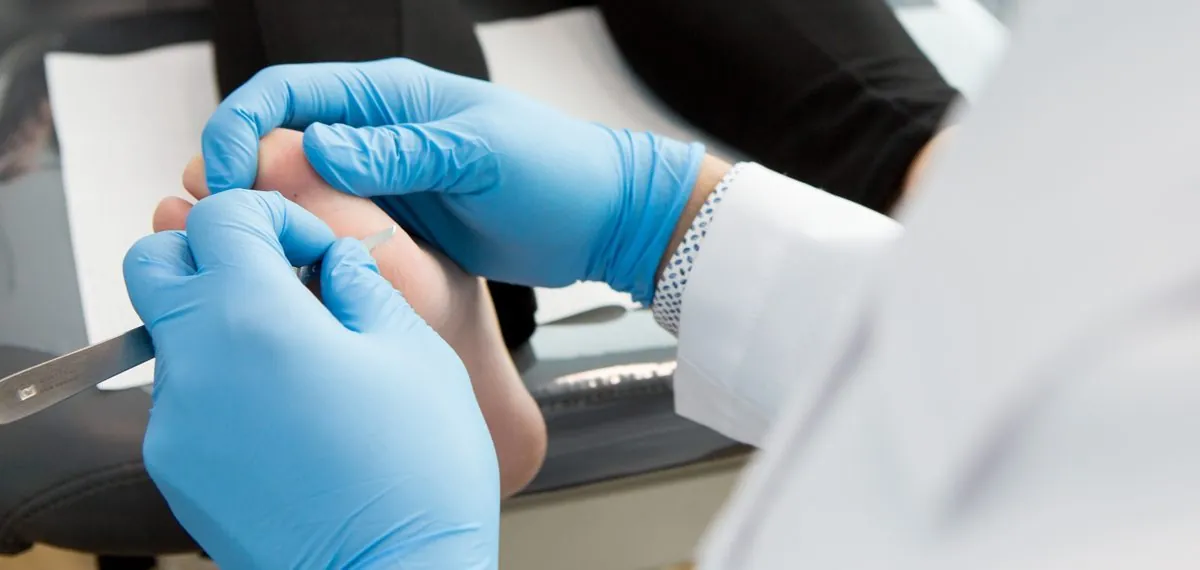Performed by a podiatrist, foot care includes many treatments and assessments aimed at preventing pain, reducing restrictions and promoting comfort. They can even be performed at home by a specialized caregiver.
A versatile professional, the podiatrist uses a variety of treatments to the benefit of your feet:
- Physical treatments;
- Pharmacological treatments;
- Orthopedic treatments;
- Surgical treatments.
A number of cases require foot care to be performed in a professional clinic. Therefore, the podiatrist and their team can provide you with a complete service to prevent and treat your foot pathologies. Naturally, all of this is done with clean, sterilized equipment.
Read on to learn more about the different treatment options.
Some examples of the most widespread foot care techniques:
Among the common foot treatments performed in podiatry you can find:
- The application of special creams;
- The prescription of medicines;
- Foot baths or the use of emollients;
- Biomechanical assessment of pressure points;
- Cutting and thinning of nails;
- Surgical debridement of corns and calluses.
Let’s take a look at the main problems that require foot care.
Onychomycosis (nail fungus)
The pain and discomfort of nail fungus (or onychomycosis) can be relieved by foot care. This fungal infection usually affects the big toe.
Often encountered in podiatry, this pathology can cause the thickening, discoloration or deformation of the nails. Unfortunately, it is also very difficult to treat this condition at home! The podiatrist, however, can help relieve and prevent the pain of onychomycosis in a number of ways:
- Oral medications prescribed by your doctor;
- A prescription antifungal cream;
- Special cutting of the nails (for thick, discolored, misshapen or painful nails).
Your podiatrist can also offer various methods to do your daily foot care and prevent nail fungus:
- Wear sandals in public changing rooms.
- Dry your feet and the spaces between your toes thoroughly after sweating or showering.
- Make sure you have a spare pair of socks.
If you have diabetes, you are also more likely to get this type of infection. Fortunately, podiatrists can tailor their foot care to your condition.
Ingrown toenail (onychocryptosis)
The foot care that the podiatrist and their team perform helps to prevent several cases of ingrown toenail (onychocryptosis). This problem is quite common and is known to cause toenail pain and inflammation.
This situation can prove to be quite undesirable when traveling or playing sports. So, if your toenail grows crooked and perforates the skin, we suggest you see a podiatrist right away.
In fact, a visit to a podiatry clinic can help you avoid many complications, thanks to specialized foot care like:
- Medical nail clipping to treat infected nails;
- Inserts of the nails used to correct the deformity;
- Antibiotic creams and baths to reduce inflammation;
- Ingrown toenail surgery, if needed.
You can also perform foot treatments from the comfort of your home:
- Soak your feet in lukewarm water and antibacterial soap.
- Purchase an over-the-counter antibiotic cream at the pharmacy.
- Clean your feet daily and dry them well.
If you have any doubts, reach out to a podiatrist for the most appropriate foot care for your condition.
Plantar warts
You can prevent the onset of plantar warts by taking care of your feet.
Not only unsightly, these lesions are also contagious! As such, it is necessary to practice proper foot care to stop this viral infection, which is often caused by the human papillomavirus (HPV).
The following podiatric treatments help against plantar warts:
- Antiverrucous medications;
- Drug injections;
- Surgery to remove the wart.
Here are some home remedies that you can employ:
- Applying salicylic acid (beware: this product can burn the skin if you use too much);
- Over-the-counter cryotherapy (seek your podiatrist’s advice before doing this cold treatment).
If you happen to be in frequent contact with people who have warts, suffer from eczema or sweaty feet, it is important to pursue foot care with a podiatrist in order to curb the problem at the source.
Corns and calluses
Corns (or calluses) are horny lumps that become lodged under the foot and can cause pain over time.
In other words, they are a localized thickening of the foot’s skin that can prove to be painful when you walk. Diabetics and the elderly are often affected by this type of condition.
To prevent corns and calluses from forming under your feet, the podiatrist will perform several specialized foot treatments:
- Specialized silicone orthotics to protect the toes;
- A moisturizing cream for the skin;
- Removal of corns and calluses.
The podiatrist can also recommend reducing the pressure points in your shoes with insoles and keeping your feet well moisturized every day.
Cracks on the feet
Foot care is very helpful in moisturizing the skin and removing calluses that often cause cracks in the feet.
The podiatrist can also offer:
- A topical ointment;
- Therapeutic taping.
Above all, remember that the best foot care against cracks is prevention!
PiedReseau provides personalized and professional foot care
PiedReseau consists of about forty podiatry clinics throughout Quebec, striving to provide you with foot care custom-tailored to your condition.
Locate your closest clinic to benefit from the best podiatry advice and put an end to your foot pain.

